The following Articles and Images have been added to the database
Arts Carleton Place is looking for between 40 and 55 talented artists for their spring Fine Art Show & Sale. Taking place at the Carleton Place Arena from April 30 to May 1, this year’s show will again be a juried one, and will predominantly showcase wall art (oil, acrylic, aquarelle, charcoal, mixed media, watercolour, pencil art, photography, etc.). There will a limited number of spots available for pottery, glass art, jewellery, sculptures and wood art. A variety of booth sizes (all Covid-19 safe) are available, and all applicants must pay a refundable $30 fee for helping with volunteer activities.
All interested artists can find full details and application information at <artscarletonplace.com/art-shows>. The deadline is January 31, 2022, and the reviewing committee will make their selections in early February at which time the registration fee will be due. Participants must be members in good standing of Arts Carleton Place for 2022 at the time of submission. Memberships are available at <artscarletonplace.com/membership>.
Arts CP had record attendance and sales at its last show. Come grow with them! For further information, please contact Suzanne at <smdeschenes1951@gmail.com>.
A free five-week virtual Practical Caregiver Training Course is being offered to people living in Lanark, Leeds and Grenville Counties. The goal is to make the caregiving experience safer and less stressful for you and the ones you care for. Practical Caregiver Training will be offered by Zoom from 9–11am or 6–8pm on five consecutive Tuesdays from March 1 through 29. Participants must commit to the same class time for all five weeks. If you are interested in registering for the course, please visit Eventbrite and search for Practical Caregiver Training — 5 Week Virtual Workshop Series.

Ahhh, good old January. Our time-honoured month to make clear, focused goals. It’s very common to do this on a personal basis, wanting to improve our health and wellbeing and initiate or complete projects and plans. But the wider view of this concept includes setting goals for our community: most specifically in this very challenging time, those that address the Climate Crisis.
We are all aware of the crisis that is looming if we don’t take the steps necessary to make our county — Lanark County — resilient and sustainable very quickly. We are reminded daily of what’s in store if we don’t get very serious about reining in Climate Change. We are confronted with news stories of climate disasters everywhere. These apparently are only a rehearsal of what we’ll experience more and more if the planet continues to warm unabated.
In preparing to write about this, I wanted to know what other counties around Ontario were doing to address the Climate Crisis. Under the Federation of Canadian Municipalities is a program called Partners for Climate Protection. Starting back in 1994, Canadian cities developed Climate Action Plans (CAP). Now, out of some 3600 municipalities in Canada, more than 400 either have or are developing CAPs. At the encouragement of Climate Network Lanark, Lanark County is one of those — and the only rural one in this stretch of Eastern Ontario.
It’s pretty impressive to have a look at what some of these municipalities (for instance: Durham, Wellington-Grey, Greater Sudbury and Thunder Bay) have included in their plans, including ones similar to Lanark County and Smiths Falls in their urban/rural mix. I was so impressed with how they had come up with their plans; in particular, incorporating a lot of community input and engagement.
Lanark County and Smiths Falls are in the midst of developing their Climate Action Plan for us, and are looking at a long list of actions and innovative projects.
As part of the plan, they have to set two targets to reduce local Greenhouse Gases (GHGs) over the next ten years, through to 2029. The first is a corporate target for reducing emissions from the County’s own assets such as their roads, buildings and fleet; and the second is a community target for reducing emissions by all the residents, businesses and community organizations in Lanark County and Smiths Falls.
The Intergovernmental Panel on Climate Change says we must cut our GHGs in half by 2030 if we are to avoid the calamity of the world warming by more than 1.5–2 degrees — the “1.5 to Stay Alive” slogan. The federal government has committed to cutting Canada’s GHGs by 40-45% by 2030. Lanark County has chosen to set a corporate target of a 20% reduction, with a statement to try to surpass that. The target for the community is to be set in February.
Setting targets is important. An aspirational target can drive innovation, drive goals that leap over incremental change — setting a “man on the moon” type of target. Or they can be safe, bureaucratic goals.
To date there has been no consultation with Lanark County and Smiths Falls residents on what the community target should be. There will be a community consultation on the draft report in May, but that will be after the target has been set.
Climate Network Lanark (CNL) sits on the County committee that is overseeing the development of the plan. We’re inviting you, the public, to tell us what message you want us to take to the committee about the community target.
An inspiring note here is that Lanark County’s Tay Valley Township set targets for its own Climate Action Plan of a 55% reduction for its corporate assets and of a 45% reduction for the community at large, from 2018 to 2028. More details on this plan can be found at <calendar.tayvalleytwp.ca>.
Serious climate activists around the world have made it clear that where there is a will there is a way — and if governments act ambitiously much can be accomplished. It is also clear that citizens everywhere want their governments to lead on Climate Action! CNL has received hundreds of responses to its Climate Survey, which can be found at <climatenetworklanark.ca>. We can now state without a doubt that the citizens of Lanark County want their local governments to be ambitious with their CAP and that they are ready to participate to make it happen!
CNL is asking you to support our request to cut emissions from the community in half in our County’s plan. We want to take this request from our citizens forward to the committee overseeing the development of the plan.
You can show your support by going to <climatenetworklanark.ca> and clicking on Support a 50% Emissions Reduction. We will collect all the names and present them to the Climate Action Committee as evidence that citizens support the committee and Lanark County Council in taking big steps for climate action.
There is a truly hopeful note at the end of a short Ted Talk presented by leading Canadian climate activist Tzeporah Berman at the recent United Nations climate change summit in Edinburgh. It’s entitled “The bad math of the fossil fuel industry”, and is worth watching to get your “engaged citizen of Planet Earth energy” revved up!
Resolved: that the winter of 2022 will continue to provide interesting events.
Almonte Lectures <almontelectures.net> continues to live up to that resolution. The live-streamed editions held on the last Friday evening of each month have proven very popular, with up to one hundred participants tuning in every session.
The winter series will kick off on January 28 with Kris Riendeau’s presentation on the history and value of community theatre. Well-known as the editor of theHumm, Kris has been on the stage at the Almonte Old Town Hall as both an actor and a director since 2015. She and her partner Rob have formed a company of their own in a successful attempt to keep community theatre alive. The “Stages” of Community Theatre will be of interest to everyone who has enjoyed the camaraderie of a theatre company or has had the privilege of seeing a stage presentation. The Riendeaus know the joy of theatre not only from the acting and production side, but also the creative writing side, and this lecture will no doubt instill a desire to get involved in this vibrant community of players.
The second winter lecture, on February 25 will feature Johanna Filp-Hanke, Psychology Professor Emeritus, whose intense study of children in poverty led her back to Chile where she developed programs to increase children’s chances of overcoming poverty. Her many studies on the effects of poor conditions on learning have application presently when childhood poverty is an issue, even in Canada. Too Many Children and Families Left Behind will likely pull at heartstrings, but may also incite action.
The March lecture is still to be announced, but the April 29 lecture is in place, with local author Claudia Smith presenting History on the Hoof. Claudia has written a fascinating history of local rural horses, (see the December Humm for an interview about her book), and she will be presenting her favourite stories — from racing horses to those magnificent work horses behind the ploughs. Claudia has been instrumental to local history for many years, researching material through verbal interviews and observation. Her earlier books on barns and her research into local cheese factories have captured local stories that are disappearing.
The website, <almontelectures.net>, provides details on how to register for these Zoom lectures. No worries about bad hair days or winter travel. Stay safely at home next to your laptop, and enjoy these free lectures along with others. There’s always a Q&A session after the hour’s lecture, so everyone can connect with the presenter and their friends and neighbours.
Here’s a suggestion: because these lectures are supported totally by donation (which can be easily accomplished through the website), the word can be passed along to friends and relations in far-flung places so they too can appreciate the Almonte Lectures. Each one is recorded, so they can watch at their leisure. Sign up early to ensure the best seat in the house: your own living room!
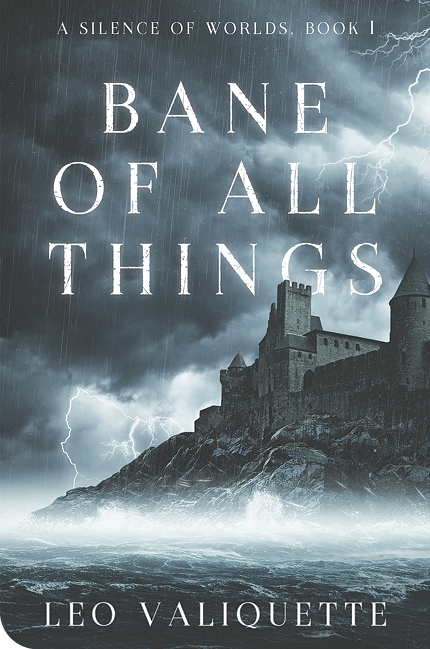
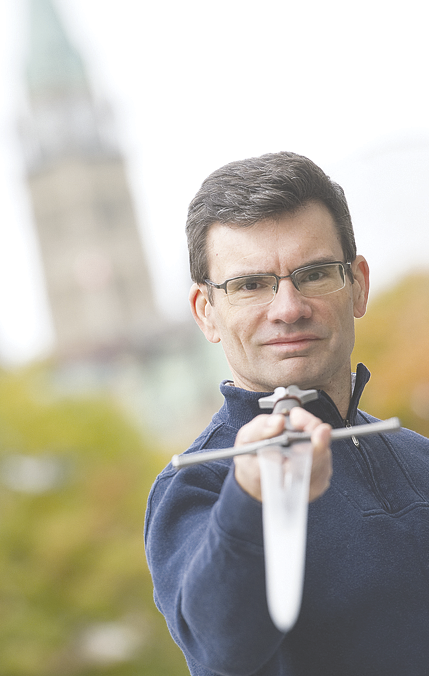
Growing up, Leo Valiquette was fond of fantastical stories. The Star Wars saga, Tolkien’s Middle Earth books, and classics like Charlotte’s Web — these were the made-up worlds Leo liked to inhabit. Later, in high school, he liked to make up stories and was admittedly “a Dungeon & Dragons nerd.” At some point, he fashioned himself a decent writer, too. Now, many years on, he has realized a lifelong dream and published his first novel, an epic fantasy called Bane of All Things.
It’s an exciting time, he says, but admits it’s all taking some time to sink in — that the book’s been published, and is receiving some notably wonderful reviews.
“It’s all rather surreal, to be honest,” Leo says. “I am the sort of person who is always focused on what’s next. And what’s next is, ‘OK, the book has published, what must I continue to do to drive sales?’ Which is valid, but I need to make myself take time to smell the roses and relish the fact that, yes, I have just published my first novel after having worked toward this life goal for 20-plus years.”
Leo, who lives near Port Elmsley with his wife and son, believes his experience working in a museum, then as a journalist and a newspaper editor, and finally as a corporate business writer, have all helped him become a published author.
His interest in history first drew him to museum work. “But at that time, the mid-90s, career opportunities in the field were a bit scarce, and I looked to return to school. I had always been a strong writer and had been making up stories since my early teens. So I decided to return to school for journalism, because I believed it would give me a strong foundation for any kind of writing career. This has proven to be true.”
Indeed it has. Bane of All Things was published in early December by Inkshares, a small innovative American publisher.
Leo explains the plot of the book, which is the first in a series of four: “Bane of All Things is a story about two young people. Ryn is a soldier sworn to serve the church of the land, haunted by his part in the massacre of a village, who comes into possession of an ancient relic with a will of its own. Josalind is a suspected witch but is really something else entirely who threatens to shake the church to its very core. They must learn to take control of their own fates and not just be the pawns of others, as well as come to terms with the impact their choices hold for the rest of the world.”
But the story doesn’t end there.
“I have it plotted out as a four-book series, titled A Silence of Worlds,” Leo explains. “The stakes will continue to rise, and the reader will continue to learn more with each book about what the stakes really are. The characters themselves will face harder choices, with greater awareness of what impact their choices will have and how they must mature and grow as a consequence.”
Book 2, called The Crucible Tree, is already written. Leo’s in the midst of revisions before he passes it on to his publisher. The release date for that one has yet to be determined.
A cancer survivor, Leo says writing these books has been a sort of therapy during ongoing treatments, but it’s also been a challenge too.
“Sinking into my own created worlds, going right back to being a Dungeons & Dragons nerd in high school, has always been an escape. Living with cancer (metastasized melanoma) for the past two years, it’s definitely been a kind of therapy to be able to focus on my fiction, and on the process with my publisher to get the book out the door. On the other hand, it’s been a definite struggle to continue to write because of the physical toll taken on me by the cancer and by the treatments.”
Leo credits his wife Natalie for helping him further his dream of becoming a career author. He also draws inspiration from his autistic son William, who “everyday teaches me the virtues of kindness and empathy.”
If you’re a fan of gritty epic fantasy books, you’ll be happy to know that Bane of All Things is available to order from Amazon and from Chapters-Indigo (both online and in-store at select locations).
“It can also be ordered for in-store pickup from various independent bookstores,” Leo says. “Some independents are also stocking it in-store, such as Toronto’s Bakka-Phoenix Books — Canada’s oldest science fiction and fantasy bookstore.”
Early reviews of Leo’s gritty fantasy have been exceptional.
“Visceral and vivid, Bane of All Things is a gorgeously imagined ride,” writes Kate Heartfield, author of the Alice Payne series and The Embroidered Book. “I enjoyed getting to know these characters and the world of monsters and magic they inhabit. A terrific read.”
One day in the new year, perhaps, you’ll be able to meet the author and buy Bane of All Things at a book signing or a reading in an Ottawa Valley bookshop. Leo is anxious to do so, but understandably wary as well.
“I am hoping to have formal reading and signing events in the near future, but between my health challenges and the latest twists with the pandemic, I am being cautious about that right now.”
For now, you can learn a lot more about the author and the book — including a nifty detailed map of the world in which the story is set — as well as reading some more very flattering initial reviews of the novel, by visiting his website at <leovaliquette.com>.
And, of course, you can buy the book too! Bane of All Things just might be the fantastical escape you’ll enjoy in the new year — perhaps as a gift to yourself (you know, the one you didn’t get over the holidays). It sounds like an absolute winner all around.
Good news! The second annual online birdhouse auction, code name Birdhouse Bonanza, is coming in the last two weeks of April, 2022. This year’s proceeds will go to the Mississippi Madawaska Land Trust <mmlt.ca> to enable them to continue improving the High Lonesome Nature Reserve off Carbine Road in Pakenham. It is fitting that the MMLT is dedicating this event to the memory of the late Michael Macpherson who loved High Lonesome and worked diligently to protect this site during his lifetime.
The improvements at High Lonesome will include:
the installation of 114 meters of a new rail fence along the length of the property’s shared laneway to protect the forest from ATVs;
moving the pedestrian entry gate;
adding a designated public parking area and rail fencing as protection of the front meadow for Monarch butterflies and other delicate species;
new signage and trail markers for hikers.
The estimated cost of the project is $10,000. Thanks to a $1,500 Mississippi Mills Municipal grant and some private donations, work has already begun, but we want to shoot for the moon with the birdhouse auction to get the job done. Our goal is $7,500. We made close to this amount last year and know it can be done. The money raised will help to enhance 200 acres of safe and beautiful unspoiled forest, ponds and meadows for people to hike through, picnic in, or participate in organized family events. It is not only for the immediate community. High Lonesome Nature Reserve is also an ideal destination for those in Ottawa, the Ottawa Valley, and surrounding areas, bringing recreation and tourism to the Pakenham and Almonte areas. Mike Macpherson would be thrilled if we’d climb to the peak and sit for a time of reflection on the bench donated in his honour.
To realize our goal of $7,500 for the High Lonesome improvements, we are asking birdhouse builders in the community to build and donate their creations as auction items, and birdhouse buyers to dig deep to buy the beautiful, artistic birdhouses at the online auction in April, 2022. Together we can make this happen! Questions? Contact Glenda Jones at <aljones@xplornet.com> or 256–6479, or Barbara Carroll at <barbaracarroll493@gmail.com>.
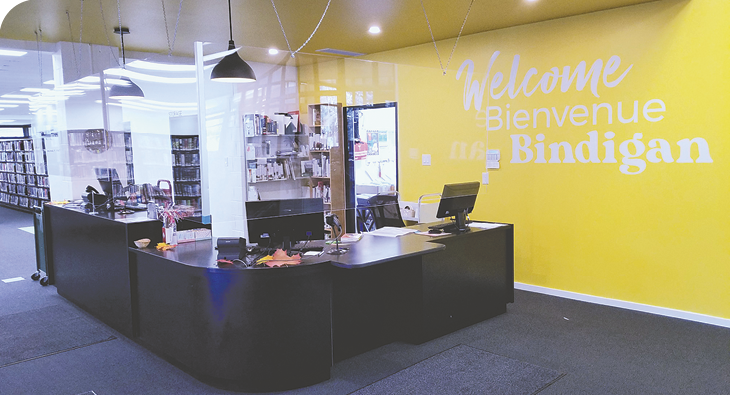
After a year-long renovation, the Carleton Place Public Library is open to the public again!
The updated interior features new meeting rooms, a laptop bar, new shelving and flooring throughout, energy-saving LED lighting, and fun reading cubbies for kids.
“The new interior is vibrant, accessible and welcoming,” explains library CEO Meriah Caswell. “We are thrilled to be able to welcome the community back to their library and want to thank everyone for their patience and understanding during this long process.”
Created in 1846, the Carleton Place Public Library is one of the oldest library systems in the area, with the renovations marking the library’s 175th anniversary.
While the interior renovation is complete, the accessible ramp outdoors is expected to be finished soon. Until then, alternative services such as personalized book selection and curbside pickup are still being offered to those affected.
Public reaction to the renovation has been overwhelmingly positive. People are excited to tour the facility to see the improvements and browse the shelves again.
A Grand Reopening celebration is planned for January 13, with a ribbon cutting ceremony, local dignitaries, and guided tours of the refreshed space. Everyone is invited to attend. Please visit <carletonplacelibrary.ca> for more details.
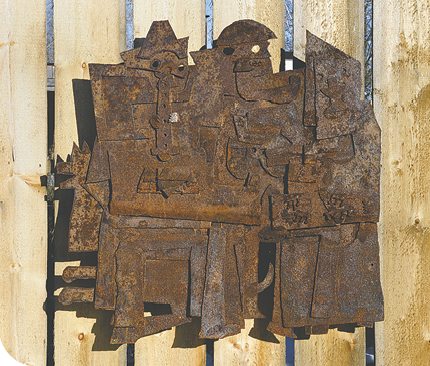
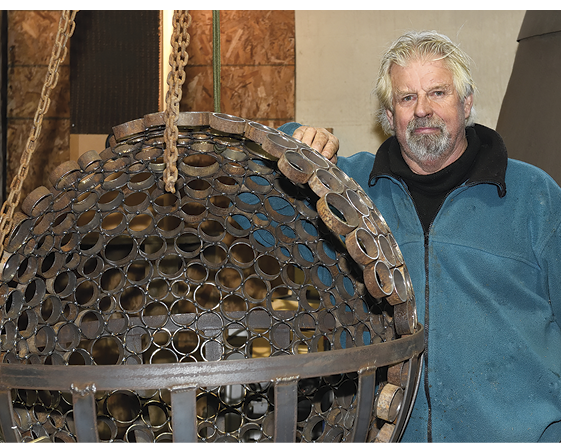
Art… and Soul
Ten years ago I wrote that “Renfrew metal sculptor Jack Stekelenburg enjoys challenging our preconceptions of art. Following in the footsteps of his philosophical and artistic mentors, he creates art as an unconscious, unscripted, wordless act of emotional expression. He also plays and experiments and grows as an artist.”
Sixteen years ago the writings of Ralph Waldo Emerson and Henry David Thoreau inspired a construction worker from Renfrew to become self-reliant and pursue dreams of a different life. Today Stekelenburg’s Walden Three Studio and Sculpture Garden on the outskirts of Renfrew is a fascinating testament to the lasting influence that the Transcendentalists of the 19th century have had on him.
It was existentially satisfying to confirm that Jack remains true to his literary inspirations, and that his efforts continue to bear unique results. A winter walk among his outdoor sculptures reveals an exciting artistic progression — confirmation that following the advice he shared a decade ago is personally fulfilling. Jack’s advice then and now to anyone approaching retirement is to “rekindle the passion of your youth. Resurrect those things that moved your soul and your spirit — art, music, writing, nature, dancing, travel — whatever. Don’t worry whether you’re ‘good enough;’ don’t worry about what your friends think.”
Stekelenburg has come a long way from when his friends first teased him about sculpting “boat anchors”. Jack pays attention to his different drummer, and his artistic inspiration remains intuitive. When he looks at pieces of scrap metal, he envisions and then creates wonderfully imaginative abstract sculptures of — almost anything. One of my favourites is his scrap metal version of Picasso’s century-old painting, Three Musicians (below, left).
A closer look at Jack’s sculptural version reveals the extent of the creativity and painstaking workmanship that has produced this rugged outdoor version of a seminal masterpiece. His choice of subject is the perfect match for his medium. MoMA describes the original painting thus: “The intricate, jigsaw-puzzle-like composition sums up the Synthetic Cubist style, the flat planes of unshaded color recalling the cutout and pasted paper forms with which the style began.” In my untrained (but highly experienced) opinion, Jack’s piece measures up well.
Another piece of Jack’s that I admire for its originality and joie de vivre is Steampunk Sally. If this big-as-life sculpture doesn’t lift your spirits and put a smile on your face, it’s time to check yourself for pandemic depression.
A recent theme in Jack’s work is his exploration of spheres. The works of American metal sculptor Michael Malpass (1946-91) caught his attention, and he recognized a true kindred spirit. Malpass wrote: “From the discards of society I simply try to create a beautiful object.” Jack describes himself as a modern-day hunter-gatherer, collecting scrap metal and doing runs to the dump to salvage other people’s junk. He invested in a plasma cutter and blacksmith’s forge and continues to figure out how to construct amazing and increasingly complex spherical compositions. He is putting the finishing touches on a beautiful sphere 32 inches in diameter, consisting of over 500 pieces of pipe that will weigh around 100 pounds. You can see a brief video of the piece under construction at <facebook.com/Walden3Studio>.
Another new initiative growing in popularity is Jack’s one-day workshops where you create your very own sculpture. You, or you and one or two friends, can book a day of creativity where your imagination is your muse and Jack is your metal sculptor. His outdoor workshop is replete with metal objects of every shape and size, and you can design an objet d’art that Jack will fashion into a rugged sculpture before your very eyes. Jack’s sculpture garden is brimming with an astonishing array of salvaged metal pieces, so you are limited only by your imagination and time. It’s probably wise to have an idea of what you want to create, but then again, spotting an extraordinary piece can trigger a true “eureka” moment.
Jack enjoys sharing his knowledge of how he uses his plasma cutter and welding tools and grinder to construct your masterpiece. Watching your piece emerge from the forge becomes an unforgettable component of your lasting enjoyment of your very own creative recycling triumph. The testimonials glow with appreciation of the whole experience, so once it warms up this spring, you can certainly add it to your list of safe outdoor activities.
Back Story
It was only in 2005 that Stekelenburg decided to indulge the passion for art that he had put on the back burner while he started a career in construction and raised a family. Intrigued by metal garden art, in 2005 he signed up for a course in welding. In 2008 he traveled to the Mount Everest Base Camp, reassessed his life, and decided to pursue the passion of his youth. After interviewing Jack in 2012, I wrote the following paragraph, and after interviewing him a few weeks ago, it seems utterly appropriate to present it again:
Stekelenburg’s gift is his unwavering determination to discover, and perhaps re-invent, himself. His life, like his art, continues to be a work in progress. Stekelenburg’s favourite role model is American abstract metal sculptor David Smith. This quote from a speech Smith gave in 1959 at Ohio University explains why: “Art is made from dreams, and visions, and things not known, and least of all from things that can be said. It comes from the inside of who you are when you face yourself. It is an inner declaration of purpose; it is a factor which determines artist identity.” Stekelenburg’s art is worthy of attention because he trusts himself.
The videos he has posted on Facebook show how he overcomes technical and physical challenges, but most of all, they show how Jack Stekelenburg’s indomitable spirit continues to forge ahead. His coordinates appear on the back of his Artist Trading Card; this I can guarantee — at the very least he will brighten your day.

Mary Berry, that paragon of pastry and smiling tourist guide, has chosen to visit our humble home for an upcoming “Notflix” series. It’s a little intimidating to think we’ll be up there with the Downton Abbey castle, but hey, this is our castle, so I’m sure I can haul out the stops to make her stay the epitome of elegance and social grace.
She arrived last Friday as it began to snow. Her limo pulled up and TV crews, cameras, cables and lights were everywhere as the three dogs exploded out the door to greet her. She was polite as she brushed snow off her designer coat, but it was obvious she wasn’t a dog person when Diva licked her face. No apologies could be heard over the barking, so why bother. First faux pas, right there!
Below is Mary’s commentary for our house tour. Listen for her pleasant tone of condescension…
“This lovely country home has been on the property since 1994. Surrounded by 20 acres of woodland showing definite signs of LDD damage, this charming property supposedly boasts lovely summer gardens, not now discernable under too much snow. We were welcomed by the owner’s tribe of dogs and admonished not to let the snarky little cat out as we crowded into the entry hall, dripping snow. The lady of the house seemed to be cramming the vacuum into the front closet as she politely shook hands all around. (Probably my second faux pas).
“While she chose a more suitable wardrobe, she engaged her husband to regale us with history far too complicated to remember while we toured the home, ignoring the frantic barking behind us. The living room with well-worn furniture indicated a cozy space draped casually with a well-used afghan and a plethora of dog toys everywhere. The art collection was eclectic, and could have used a dusting before we arrived. According to the lady of the house, the cleaning woman ran off with the kitchen staff a week ago and she’s been left to manage on her own.
“I kept smiling sweetly as we peeked into the library where an antique desk scattered with papers held the place of honour. Bookshelves were overloaded with everything from the Canada Post directory to novels and textbooks, indicating the owners’ notion that every book should be kept. We thought it wise not to look in closets!
“The bedrooms displayed quilts and afghans, the work of the lady of the house, but off-limits to viewing due to the cat hiding under the covers. She definitely didn’t want company.
“As usual we were treated to a brisk walk in the woods. I donned my best hat and walking boots to hike the well-marked and groomed trails while the man of the house named every tree and its significance, every signpost and whom it commemorated, every rock they’d moved, and soooo much more. Our short hike lasted long enough to freeze my fingers, frenzy the dogs, and annoy the camera crew. (Too long, maybe?)
“Cocoa would have been welcome when we got home, but there was no time, as dinner preparations were next on our agenda. Off to the kitchen next where we were preparing my famous Jell-O dessert for presentation at the evening’s dinner party. The obstinate cook had left chaos when she left with the maid, and the lady of the house raced around assembling bowls and doing her best to prevent me from investigating the array of pots and pans stashed in the stove drawer. We laughed heartily as I talked her through boiling the kettle, combining the Jell-O powder with the hot water, stirring vigorously, and adding the cold water. We popped it in the fridge, shoving the carrots and left-over stew aside. Too bad the maid hadn’t cleaned that fridge before she left. We contemplated cake, but the oven was… well, let’s not go there.
“At precisely 4pm friends began to arrive for 4’s, that splendid part of the day when lights are low to hide the dust, animals are fed and quiet, dog toys are shoved aside, and the wine is poured and all is right with the world. The homeowners welcomed us like long-lost cousins as the TV crew plowed through the assembled guests. We drank and made merry, savouring local cheese and Ritz crackers, until we were called to table for a feast of left-over stew served in the dining room where placemats provided casual dining. Of course, my Jell-O dessert was the highlight of the dinner. Served in elegant crystal glasses of unknown vintage, the Jell-O shimmered beneath a soupcon of Cool Whip. All agreed it was a dinner they would replicate at home in the near future.
“We left the residence at the crack of dawn the next day, having spent the night in the production trailer parked in the driveway. We eschewed the offer of cornflakes, and beat a hasty retreat to the nearest Tim Hortons”.
Whew, that was exhausting! But we’re ever so proud that we pulled it off. You can watch for our segment some time in the distant future. Mary Berry is indeed the queen of elegance, and I feel we definitely lived up to her expectations. And if we didn’t — well, low lighting will hide a lot of housekeeping flaws, and who can resist Jell-O?
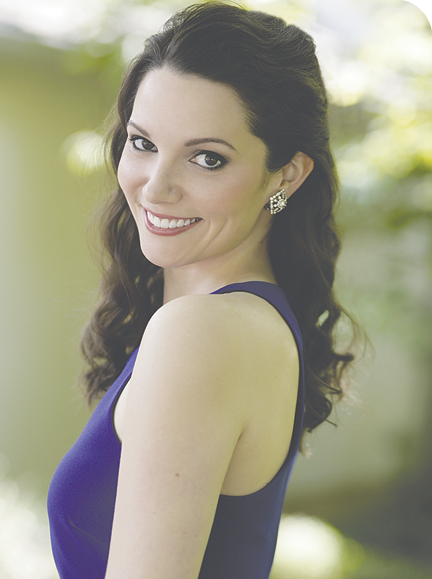
Internationally acclaimed soprano and Almonte resident Mireille Asselin returned home briefly after performing the role of Amore in the Vancouver Opera’s production of Glück’s Orfeo ed Euridice, before setting off again to perform as a soloist in Handel’s masterpiece Messiah with the Rhode Island Symphony Orchestra. Mireille will be performing with pianist Frédéric Lacroix and violinist/violist Brenna Hardy-Kavanagh on January 16 at the Almonte Old Town Hall, in a poignant program dedicated to the memory of Michael Macpherson, a beloved community member and ardent supporter of Almonte in Concert. Despite her busy schedule, she found time to sit down with Maureen Nevins, Artistic Director of Almonte in Concert, for an interview.
Who or what inspired you to pursue a career in music?
Mireille Asselin: I have many music lovers in my family but no professional musicians, so I didn’t really know that a music career was an option until I was in high school and saw my peers preparing for their university auditions (I was in De La Salle’s fantastic arts program in Ottawa). I remember trying to choose between a music or a science degree at that age, and it essentially came down to the fact that I knew I’d regret it if I didn’t at least explore an opera career before opting for an alternative. Luckily, one thing sort of led to another and I’ve been able to slowly build my career over the years, having been given absolutely wonderful opportunities along the way. Now I can’t imagine doing anything else!
What have been the greatest challenges of your career to date?
Well, the most recent challenge has certainly been adapting to the curve balls thrown at my industry by Covid. All performing work essentially evaporated for over a year, so the challenge was not only “how do I make an income”, but also “what do I do with my time?” and “who am I if I don’t sing?”. It was immensely challenging to see my friends and colleagues lose their livelihoods, homes, and sense of purpose… but also equally heartening to then watch them reinvent, create, and thrive in new and ever-changing landscapes. It has ultimately led to lots of really wonderful new virtual and recorded projects, innovations in virtual rehearsal capacities, and a renewed focus on equity and diversity in our field. Clearly, the challenges continue with new variants shuttering concert halls once again. But artists are a resilient bunch, and I will do my best to continue to advocate for them and support my community.
How do you make your repertoire choices from season to season?
This is largely out of my hands, to be honest! I see which contracts and projects come in and try to fit them into my jigsaw puzzle of a schedule. But every so often I have the opportunity to curate a recital like the one I’ll be doing here in Almonte, and I have free rein to dream up something new. In this particular case, it started as a request to make a concert that would honour the memory of Michael Macpherson, and so I was able to take inspiration from some of his favourite music and let my imagination lead me from there.
Who are some of your favourite musicians or composers, past and present?
Favourite musicians include Edith Piaf, Glenn Gould, Beverly Sills, as well as basically everyone I get to work with on the concert scene (my colleagues inspire me!).
Favourite composers – past: Poulenc, Bach, Mozart, Handel and Stravinsky. Present: Cecilia Livingston, Fred Lacroix, Serouj Kradjian and Mark Sirett (you’ll hear them all on our program at Almonte Old Town Hall!).
As a musician, what is your definition of success?
This is a tough one. In the past, I would have said making my living entirely from music and getting to work with the top ensembles and theatres in the world. But I think that’s an overly simplistic definition in our post-pandemic reality. I am reminded that so many truly phenomenal musicians make a living by piecing together a variety of income streams, making them no less of a success. And some of the best art is in fact being done off the boards of the huge glitzy stages, which frankly aren’t as nimble and able to adapt to changing times. It is also an immense privilege to be able to make music, in person, with other musicians. One I will no longer take for granted! So now I would simply say, success as a musician is being able to make music joyfully, and regularly.
What would be the most important piece of advice you would offer to aspiring musicians?
I would tell them to honour what makes them unique. The classical music world used to be much more rigid and unwelcoming of the blending of different styles and approaches. That is no longer the case. Yes, practice. Yes, work hard on your technique. Yes, be resilient and learn to take constructive criticism. But also, do not erase where you come from or silence what you have to say. These things are critical and will help you stand out in a crowd.
Where would you like to be in 10 years’ time?
Here in Almonte, with my husband and my dog, bopping around to my gigs as needed and hopefully making time in my schedule to finally see the famous “Light Up the Night” I’ve been hearing so much about. ?
Mireille will be performing on January 16 at 2pm in the Almonte Old Town Hall. The performance will also be live-streamed, with the recording available to view on-demand online until January 18. For further information and ticket purchases, please visit <almonteinconcert.com>. Almonte in Concert is also very pleased to have Mireille on their Board of Directors.
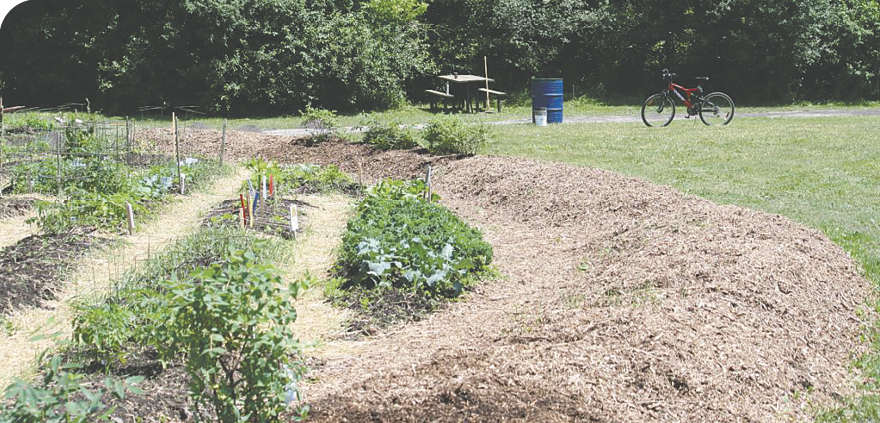
A community garden for every neighbourhood? There are many reasons why folks are turning their thoughts towards growing a few potatoes and carrots: global supply chain disruptions, extreme weather events, organic food untainted by chemicals, local food insecurity, just looking for a healthy outdoor activity, higher costs in the grocery store, more time on our hands for home projects, and the need to find something healthy for the kids to do are only a few!
So why grow food in a community garden instead of your own back yard? Well, some of us live in an apartment or condo, or know absolutely nothing about gardening and want to work and learn alongside experienced folk.
Community gardens can take many forms; most often there are individual plots, ranging from 50 to 1000 square feet, that are assigned to individual gardeners; many have a communal area where veggies are grown for a social purpose such as a food bank; and many are a combination of both types. While growing veggies in our own private spaces is great, growing food together in public spaces has the additional benefit of building a sense of community. It can eliminate some of the loneliness and isolation that feature prominently in our society — particularly in a time of ongoing pandemic. Growing food together in a community space is a very powerful way to bring people of all generations and abilities together with the benefit of producing healthy nutritious food.
If you are trying to locate an existing community garden, check with the usual suspects — your municipal government, your local Horticultural Society, the local Master Gardener group, or even local Facebook groups. In Ottawa, I recommend starting with Just Food <justfood.ca>; in Almonte with Carebridge Community Support <carebridge.ca>; in Carleton Place with Carleton Place Community Garden (on Facebook); in Smiths Falls with the Rideau Environmental Action League <realaction.ca>; and in Perth with The Table <thetablecfc.org>. Unfortunately demand has outstripped supply, and in many cases there are waiting lists.
Where do you turn if you want to bring a bunch of folks together to start a new community garden? Just Food, an umbrella group for Ottawa community gardens, has a wealth of resource material on starting a community garden. All of the organizations mentioned above are worth talking to as well.
So why don’t we have a community garden in every neighbourhood? It seems a bit of a no-brainer to create a garden in the little park just down the street. After all, it seems that many parks are little more than a flat piece of grass and a play structure. Unfortunately, there are often a lot of hurdles in the way. Resource-strapped park-maintenance folks tend to resist any change that is going to make their life more complicated — increases in liability, complaints by neighbours and more costly maintenance are important factors.
I remember doing a workshop several years ago with a gardening group in west-end Ottawa that was one of the first to obtain permission to create a garden in a city park. Nervous city bureaucrats had created a long list of rules such as no plants over two feet tall and no straw for mulching. It seems that their fevered imaginations had conjured up myriad ways that teenagers could misbehave in a vegetable garden. There are now more sensible rules, but the costs of complying with soil tests and construction standards can be quite daunting.
Not every location is suitable. Access to water to irrigate the garden may be very costly. There may be opposition from neighbours who believe that veggie gardens can be a bit of an eyesore and take over spaces for which they have a competing vision.
So where are you going to go to start your community garden? I have visited a lot of successful community gardens, and some not-so-successful ones, and have led the charge in trying to create new gardens or to expand existing ones and have not found any magic recipe for success.
How about a faith community? Some of the more successful long-term community gardens that I have visited have been on the grounds of a church. Long-term commitment and a more formal governance structure appear to favour stability.
How about a food bank? This has been a much more viable proposal in the last couple of years. Government pandemic relief measures have resulted in more funds being available to start a garden, and more volunteers have been stepping up to help with food bank initiatives. If a chunk of land and gardening expertise can be found, very motivated folks can grow tons of food.
How about a social agency such as a not-for-profit housing corporation? How about a landowner who is willing to donate a small acreage for a community garden? How about a school or Youth Centre? With schools there is the problem of no one being around in the summer to water and weed the garden. A solution could be a partnership with a Youth Centre that is running summer camps.
When a community garden is well planned, well-constructed, well maintained and has the support of a community, however that is defined, the results are astounding. I have experienced many moments in community gardens that have touched me deeply. People develop strong bonds and care deeply for their neighbours and their community. Gardeners show off their carefully tended spaces with pride, and are happy to share knowledge and a few fresh veggies.
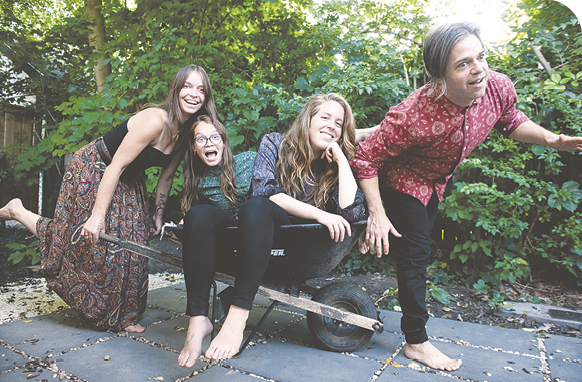
With excitement and joy, Folkus planned their 20th season this fall. We’re still hoping for joy, and we’re pivoting and pirouetting and taking all the precautions we can to ensure a safe and beautiful evening together. We really wanted to put Tragedy Ann and The Pairs on our stage because they absolutely love to sing, and they bring a delightful energy to the stage.
One of the things we really miss is gathering together. But some of us still aren’t ready to. And that’s ok. To make sure that people can still participate from the comfort of their own homes, Folkus will be offering a streaming option for this season. You’ll be able to put up your feet, gather on the couch, open a bottle of something special, and enjoy our professionally produced offering. Our first show of the season will be a celebration of singing, of friendship, family and community.
Tragedy Ann are based in Guelph. With intimacy and care, Liv Cazzola and Braden Phelan favour a flashlight over a spotlight in songs about community, nature and hardworking hospital staff. Braiding organic vocal harmonies with accordion, singing saw, guitars and ukulele, Tragedy Ann’s arrangements are as delicate as they are driving. They’re currently recording a new album, and our audience will be some of the first to hear the new compositions.
Paul Corby of Corby’s Orbit, Roots Music Canada, writes: “A collective fresh breath was taken as Tragedy Ann took the stage and emanated romance, harmony and joy with such charm and dynamic interplay that the hush became palpable. The applause rose in wave upon wave throughout their set.”
The Pairs are a joyous and energetic female-fronted folk-pop group hailing from London, Ontario. Led by the powerhouse (classically trained) vocals of sisters Renee and Noelle Coughlin and Hillary Watson, they are backed by recovering punk drummer Steve Plimmer. The Pairs create acoustic harmony pop tunes grounded in unique rhythms that will hug your eardrums and fill you with joy.
According to Miranda Mulholland, Artistic Director of Muskoka Music Festival and Dockside Festival, “The Pairs became a festival favourite after their very first song. Their infectious energy, joy and talent had the entire audience enraptured immediately and they have become the band most requested to return ever since.”
As of our deadline, season passes were still available at our ticketing partner, Tickets Please <ticketsplease.ca/folkus>. Individual in-person tickets will go on sale January 5. Our virtual tickets will also be sold through Tickets Please. There will be no limit on streaming numbers, but the show will be available for a limited time only.
Indoor capacity will be limited to 150 per show, and everyone attending must show proof of vaccination at the door, no exceptions. Per provincial regulations, a QR code will be needed — see <folkusalmonte.com/about-folkus-concert-series> for how-tos if you need help. Masks will also be a factor; please don’t leave yours at home. As things stand, we will not be serving beverages at our concerts this year. This may change, but safety is a moving target. Doors will open at 7:15 to allow for ample time for screening. The concert will begin at 8pm.
As we’ve mentioned before, things are going to look a little different this year for Folkus. We hope to see you at our shows, and we’re looking forward to having live music in the Almonte Old Town Hall again.
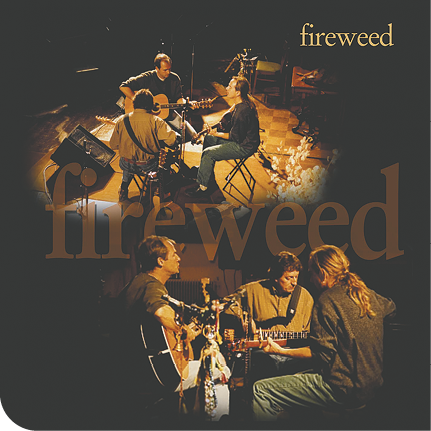
From the organizers of the Snow Moon Festival: "Unfortunately, after much discussion, we've made the difficult decision to postpone the festival to (February 4) 2023."
One thing is certain in these uncertain times — creativity is alive and flourishing in our area! Local venues have expanded patios, poured out into parking spaces, and even used hula hoops to socially-distance audience members keen to keep on experiencing the joys of live performances. Now that winter is upon us, the inventive folks at Wintergreen Studios <wintergreenstudios.com> up in South Frontenac are thinking outside the box — and into the fire ring — for their upcoming Snow Moon Festival scheduled for February 12. This outdoor celebration of winter, the natural world, music and friendship sounded completely intriguing, so we contacted musician and co-organizer Gary Rasberry to find out more.
theHumm: Before we get to the details about who, where and when, can you tell me a bit about the why? I’m curious to know how the concept for this event first sprang into being.
Gary Rasberry: As important as the “Why” question is, we began with the “Why not?” question. And while this may seem like a less pragmatic way to approach an idea or a project, it has its own logic. “Why not” involves a leap of sorts — a certain amount of daring, of challenge, and a willingness to entertain what might be possible.
In the case of the Snow Moon Festival, it was an idea born out of pandemic fatigue, and hatched, not surprisingly, over coffee during a break at a Wintergreen work bee around a year ago. At the time, our pandemic reality consisted mainly of post-lockdown “bubbles.” The bubble concept at the time involved people spending time within a group that could include family, and a fluctuating number of others, as dictated by whatever Covid restrictions were in place at that particular time.
We knew from our own experience that people were hungry for those things that had given their pre-pandemic lives both mooring and meaning — and pleasure. Live music, lively conversation, and sharing meals were the three things we wanted to include. It had become clear at the time that outdoor gatherings were deemed safer than indoor gatherings, and, as a result, people were (re)turning to outdoor activities in ways they hadn’t previously considered.
So why not create a live outdoor music festival that offered folks a unique opportunity that included both mooring and meaning? Why not embrace the various pandemic constraints and limitations, and work within the framework of the government-mandated health and safety directives to purposefully create an event that was first and foremost safe, but just as important, festive, fun and meaningful? As a small group, sitting socially-distanced over coffee at Wintergreen Studios that day, our thought was “Why not?”
We began to imagine an outdoor festival, where the audience would be happily bubbled. This led to creating a physical set-up built around a number of “fire rings”. Essentially, each bubble of people would have their own campfire located in a picturesque meadow. In addition, there would be a central fire ring and a stage for live music. The food menu would feature items that required minimum handling, with disposable paper wrappers thrown into the fire.
What kinds of experiences — musical and otherwise — await people who attend this unique festival?
Our hope for the Snow Moon Festival is, first and foremost, to offer people opportunities to safely enjoy great live music, good company, as well as time in a beautiful natural setting.
The festival honours the quiet grace and beauty of the land we walk and acknowledges the Indigenous peoples who nurtured this place before us, and also those who will continue to do so after we are gone. An Elder will open and close the festival, and we will offer a variety of dishes, including Indigenous cuisine.
While it could well be cold outdoors in February, we will keep the fires going, and with delicious food, warm company (as well as blankets — this is a BYOBlanket event) and amazing music, we expect everyone will feel warm, inside and out. For those who need to get up to stretch their legs and get their heartrates up a bit, we offer hundreds of acres with clearly marked trails for an afternoon hike, before returning to the music and fires.
What do you and the other organizers hope people take away from their time at this event?
Most of us know that we will be talking about the pandemic for the rest of our lives. Much of this talk, 5, 10, 20, or even 30 years from now, will come in the form of stories. Our hope is to offer people an opportunity to create their own unique stories, based on memorable moments, that they will still be telling long after the pandemic has receded. And a deepened connection with the land too.
Now for the musical nuts and bolts. Can you tell me a bit about the performers?
In keeping with health and safety, we have chosen to create a musical line-up that features local musicians, and there is a rich well from which to draw upon. In addition, we looked to musicians who are “friends of Wintergreen”, and as such have performed at past events dating back even to pre-Wintergreen days.
Triola is a string trio that has performed regularly at evening concerts and special events for Wintergreen, dating back to 2011. Fireweed (whose tagline is “A little like CSN, a lot less famous) is a contemporary acoustic trio that has performed at Wintergreen before it was Wintergreen, at an annual event called the Paddy’s Lake Full Moon Festival circa 1999. Last, and certainly not least, Teilhard Frost, aka Sheesham Crow, is a masterful old-time Appalachian fiddle and banjo player, living on Wolfe Island, who has also been a part of Wintergreen events for many years. And, of course, there will be a Snow Moon Festival finale, featuring all the musicians taking part in the event.
The Snow Moon Festival is scheduled for Saturday, February 12. Find more details and registration information at <wintergreenstudios.com/events/snow-moon>. In case of inclement weather (white out, blizzard), it will take place on February 19. Covid-19 protocols will be in place on the festival site, and all attendees, volunteers and musicians will need to show proof of full vaccination.